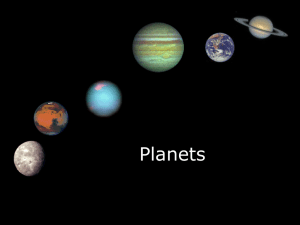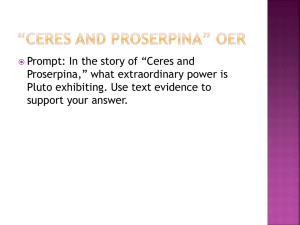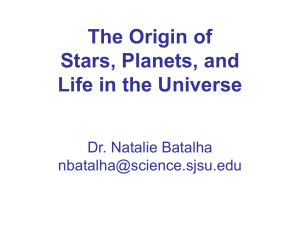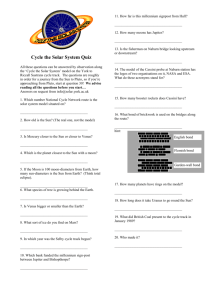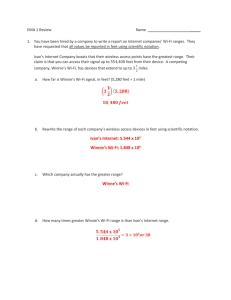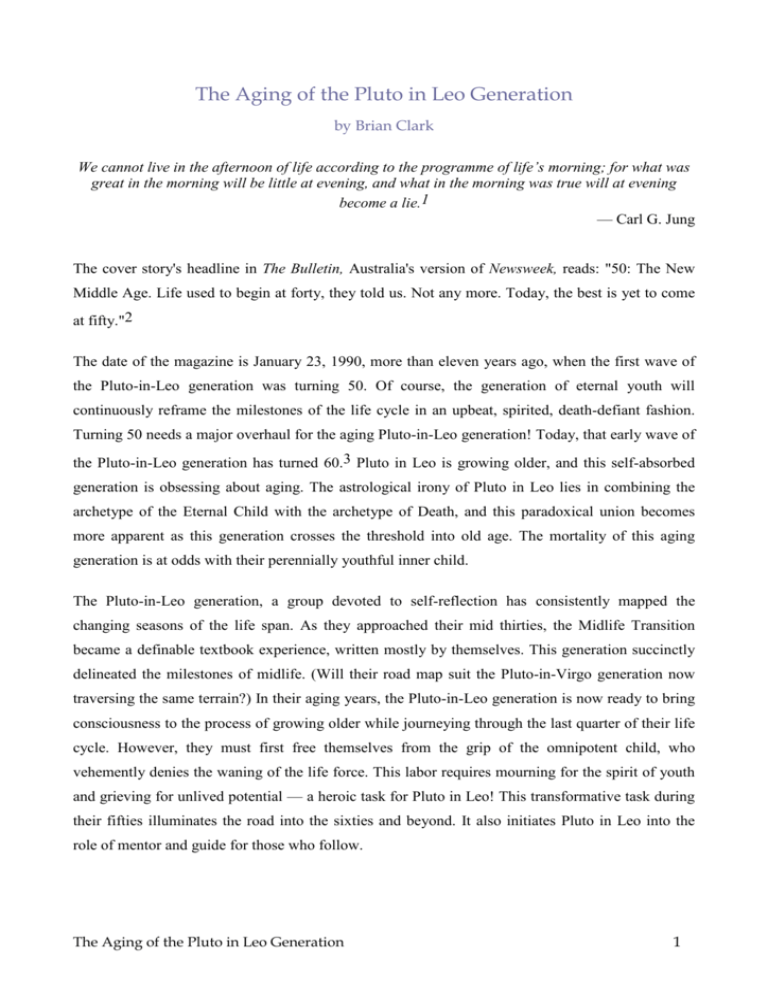
The Aging of the Pluto in Leo Generation
by Brian Clark
We cannot live in the afternoon of life according to the programme of life’s morning; for what was
great in the morning will be little at evening, and what in the morning was true will at evening
become a lie.1
— Carl G. Jung
The cover story's headline in The Bulletin, Australia's version of Newsweek, reads: "50: The New
Middle Age. Life used to begin at forty, they told us. Not any more. Today, the best is yet to come
at fifty."2
The date of the magazine is January 23, 1990, more than eleven years ago, when the first wave of
the Pluto-in-Leo generation was turning 50. Of course, the generation of eternal youth will
continuously reframe the milestones of the life cycle in an upbeat, spirited, death-defiant fashion.
Turning 50 needs a major overhaul for the aging Pluto-in-Leo generation! Today, that early wave of
the Pluto-in-Leo generation has turned 60.3 Pluto in Leo is growing older, and this self-absorbed
generation is obsessing about aging. The astrological irony of Pluto in Leo lies in combining the
archetype of the Eternal Child with the archetype of Death, and this paradoxical union becomes
more apparent as this generation crosses the threshold into old age. The mortality of this aging
generation is at odds with their perennially youthful inner child.
The Pluto-in-Leo generation, a group devoted to self-reflection has consistently mapped the
changing seasons of the life span. As they approached their mid thirties, the Midlife Transition
became a definable textbook experience, written mostly by themselves. This generation succinctly
delineated the milestones of midlife. (Will their road map suit the Pluto-in-Virgo generation now
traversing the same terrain?) In their aging years, the Pluto-in-Leo generation is now ready to bring
consciousness to the process of growing older while journeying through the last quarter of their life
cycle. However, they must first free themselves from the grip of the omnipotent child, who
vehemently denies the waning of the life force. This labor requires mourning for the spirit of youth
and grieving for unlived potential — a heroic task for Pluto in Leo! This transformative task during
their fifties illuminates the road into the sixties and beyond. It also initiates Pluto in Leo into the
role of mentor and guide for those who follow.
The Aging of the Pluto in Leo Generation
1
Table 1: Pluto's Ingresses into Leo
October 7, 1937 to November 25, 1937
August 3, 1938 to February 7, 1939
June 14, 1939 to October 20, 1956
January 15, 1957 to August 19, 1957
April 11, 1958 to June 10, 1958
As of January 1, 2001:
The Pluto-in-Cancer generation is 61+.
The Pluto-in-Leo generation is between the ages of 42 and 63.
The Pluto-in-Virgo generation is between the ages of 28 and 44.
The Pluto-in-Libra generation is between the ages of 16 and 29.
The Pluto in Scorpio generation is between 5 and 17.
The Pluto in Sagittarius generation is under 5.
The Pluto-in-Leo generation spans twenty years (see Table 1). Members of this generation, like
siblings, could be seen in three distinct subsystems: the eldest, the middles, and the youngest. Table
2 proposes these subsystems.
Table 2: Pluto-in-Leo Subsystems
1937–1945
The Eldest: War Babies
Uranus in Taurus and Gemini, Neptune in late Virgo and Libra
1941
Chiron–Pluto conjunction in Leo
1940–41
Jupiter–Saturn conjunction in Taurus
1941
Jupiter–Uranus conjunction in Taurus
1942
Saturn–Uranus conjunction in Taurus
1943
Jupiter–Pluto conjunction in Leo
1945–1951
The Middles: Baby Boomers
Uranus in Gemini and Cancer, Neptune in Libra
1945
Chiron–Neptune conjunction in Libra
1945
Jupiter–Neptune conjunction in Libra
1947
Saturn–Pluto conjunction in Leo
The Aging of the Pluto in Leo Generation
2
1951–1958
The Youngest: The Golden Child
Uranus in Cancer and Leo, Neptune in Libra and early Scorpio
1952–53
Saturn–Neptune conjunction in Libra
1954–55
Jupiter–Uranus conjunction in Cancer
1955–56
Jupiter–Pluto conjunction in Leo
After Midlife
Mid-life stands out as a very important transition, since it gives a man his first adult opportunity to
reflect and re-negotiate the identity that was originally firmly set in adolescence.4
The midlife passage embraces a period of life from the mid thirties through the mid forties
(depending upon which theorist is quoted). Astrologically, the full midlife passage could be defined
as embracing the period between the third and fourth Jupiter returns (ages 36–47).5 During this
time, the three outer planets aspect their natal placements in a dynamic way: Pluto and Neptune are
in waxing square to their natal placements,6 and Uranus is at the midpoint of its cycle. The
psychological landscape of the late thirties and early forties, symbolized by the crucial arrangement
of the outer planets, is profound. At this juncture in the life cycle, midlife offers the soul the facility
to retrieve aspects of the unlived life, to deepen one's inner experience through self-examination,
and to forge a more authentic self. During midlife, taking risks and making alternate choices may
help to reorient the course of one's life. The life force is still waxing and triumphant. Those who
enter into the demands of this period clear a path for the waning part of their life cycle, which
dawns near the 50th birthday. At the age of 50, a new decade begins which offers a rite of passage
into the last stages of the life cycle.7
The decade of the fifties is embraced by two potent astrological symbols, which profoundly
encapsulate the psychological processes taking place during this time. The first Chiron return occurs
near the age of 50, the entry point into the decade; the second Saturn return, which coincides with
the fifth Jupiter return, occurs near the age of 58–59, the end of the decade and the process of
transition. This period is also punctuated by two other important returns, which are often
underestimated: the second progressed lunar return (age 54.6) and the third return of the lunar nodes
(age 56). Until these lunar-based returns, the individual is often unaware of the powerful shifts
taking place in their personal values and priorities. The progressed Moon return offers the
opportunity to integrate and accept these changes. Through this period, the hunger to nourish the
soul permeates the mundane aspects of life. The Chiron return and the subsequent years present the
The Aging of the Pluto in Leo Generation
3
misshapen aspects of ourselves which the body and the psyche are forced to accommodate.
Whatever was sacrificed to help us find our niche in the world and conform to worldly expectations
now returns to challenge us to reconsider our earlier choices.
Also, in the midst of the fifties decade, all three outer planets are trining their natal positions,8 a
blatant clue to the potential psychological integration taking place and the variety of options
available to assist with this process. The dance of the outer planets performs some interesting
oppositions for this generation as well: Pluto opposite Uranus, Uranus opposite Pluto, Neptune
opposite Pluto. In all, five cycles are renewed in this decade, which suggest that profound
psychological alignments occur throughout the fifties (see Table 3). At present, the elder and
middle children of the Pluto-in-Leo group are journeying this passage. The oldest members of this
generation are 63 at the beginning of 2001, and their youngest siblings are 42. The generation that
worshipped immortality, eternity, youthfulness, and the magical child is navigating a new territory
that challenges these constructs.
When this generation looks back to the time when their parents were fifty, they find that startling
changes have occurred. Life expectancy, medical technology, lifestyles, the changing family life
cycle, life-enhancing drugs, and retirement options have redefined the landscape of growing older.
The life cycle, as the Pluto-in-Cancer generation understood it, has dramatically altered. Pop
psychology now labels age forty as the "new thirty"; middle age is middle youth; the decade of the
fifties has become the "invisible decade."10 Erik Erikson, one of the foremost researchers into the
life cycle, suggested that the fifties were the beginning of a mature adulthood. During this time, our
task is to nurture what is meaningful to us, not what others judge as important; this is intimately
creative and restorative to the individual.11 Chiron's return to its natal position helps to initiate us
into this task by presenting the disenfranchised aspects of ourselves, which are dear to the soul.
The Aging of the Pluto in Leo Generation
4
Table 3: The Fifties Decade: Welcome to the Fifties
Ages listed are approximate. Consult an ephemeris for your personal life cycle. Ages listed
in parentheses are those when the aspect previously occurred. Due to the irregularity of
Pluto’s orbit, Pluto’s aspects will occur at different times for different generations.
50
First Chiron return
52
Second waning square of Saturn to natal Saturn (22)
53
Fifth Jupiter opposition (6, 18, 30, 42)
54
Second progressed Moon return (27)
52–56 Neptune waxing trine to natal Neptune
Uranus waning trine to natal Uranus
Pluto waxing trine to natal Pluto
56
Third nodal return (19, 37)
59
Second Saturn return (29)
Fifth Jupiter return (12, 24, 36, 47)
60+
Uranus waning square
Initiation: Chiron's Return at 50
The Chiron Return poses the question:
'What am I going to do with this last part of my life?' 12
Chiron returns near the age of 50. Since Chiron's discovery, it has eluded categorization; it has been
called asteroid, planetoid, and comet. During the 1990s, Chiron found its niche with other Centaurs
currently being discovered mostly beyond Neptune. Turning age 50 has also eluded categorization
and takes time to find a niche in the new surroundings. Like Chiron, this period is a hybrid: the
spirited fires of immortality are now sealed up in a body that is recognized, at last, to be mortal and
finite. The inner feelings of youthfulness are confronted with the physical reminder of the aging
body.
Chiron's mythic exchange with Prometheus in the Underworld is an image that I find useful to help
amplify the process of the Chiron return. In the myth, immortal Chiron, with his incurable wound,
trades places with Prometheus, freeing the culture hero's imprisoned spirit from the rock in Tartarus.
Chiron exchanges his immortality for mortality, choosing death to relieve his suffering (the fate of
his mortal side). Yet, his choice releases Prometheus from the Underworld, an archaic symbol of
our contemporary myth of the unconscious. It is hoped that what chooses to die in us during this
The Aging of the Pluto in Leo Generation
5
transition are the misshapen and inauthentic parts of self that can no longer sustain life. If so,
Chiron's initiation could then help us to reorder our priorities, relinquish what is no longer
appropriate or authentic, and liberate the unlived spirit. What prompts Chiron to relinquish his
immortality in exchange for mortality is the pain emanating from his mortal side.
Chiron, for most of its cycle, orbits between Saturn and Uranus, attempting to bridge their
antithetical relationship but often colluding with one at the expense of the other. The incarnate
sphere of Saturn is a polar opposite of the heavenly realm of Uranus. Chiron's fate embraces both
the pain of incarnation and the fires of spirit. In reality, though, the spirit is often chained in the
cellar — buried under ancestral rubble. When the wound of living has reached its critical mass, then
spirit bursts through. So often, the inauthentic parts of the self, forged from the need to survive the
pain of exclusion, imprison the fires of spirit. These are the false aspects, often first glimpsed at
midlife that are now ready to die.
At fifty, death is no longer just a psychological process or a metaphysical metaphor: in a sense it
becomes a physical reality. Reduced energy levels remind us of this truth. The pain of living is
culminating. Death may still seem unreachable — on a faraway horizon — but it is nonetheless
visible, more than ever before. Moving toward that inevitability paradoxically holds the key to a
renewed release of spirit. The authentic aspects of the self, which are buried under the rubble, may
still be alive. Survivors of an encounter with death report one common experience: The will to live
in the moment has been forged through their rendezvous with death. When Jung wrote about this
period, he suggested that "too many aspects of life which should also have been experienced lie in
the lumber-room among dusty memories; but sometimes, too, they are glowing coals under grey
ashes."13 At the Chiron return, the "glowing coals" of the imprisoned spirit are rediscovered, and
the subsequent period is spent reintroducing them into life.
Age fifty marks a new paradigm. This new state has immense possibilities, but the map needed for
navigating the waning period is different from the one used in the waxing period, the first half of
life. Chiron returns in the post-midlife period. The midlife map, with its potent astrological cycles,
looked back; it took a psychodynamic approach to understanding the self. Childhood demons were
exorcised, the inner child was liberated, adolescence was revisited, and the road less travelled was
explored. The decade of the fifties, however, looks forward into an uncertain yet exciting new
world. Spirit is unleashed as we turn toward the western horizon of our life, and this colors the quest
for meaning with a different hue.
The Aging of the Pluto in Leo Generation
6
What was a priority in the morning of life is not as important in the evening. Erica Jong expressed it
this way: "All the things you suffer from when you're younger become far less important at the age
of fifty."14 Priorities are shifting; a redirection has been seeded. The gradual turning toward the role
of the mentor and elder is just beginning. Chiron was mentor to the solar heroes who came to his
cave to be initiated into the mysteries of life. Chiron's return marks the end of the hero's worldly
quests — the death of the embodied mentor and the entry into the elder phase of life. For Pluto in
Leo, the task of becoming an elder confronts the experience of the absent father, a common wound
for the Pluto in Leo generation. The heroic quest is to become the elder and to wrestle with the
taboo of surpassing father.
The next major astrological return comes just before the 55th birthday. The Chiron return is
followed by the second Saturn waning square at age 52, then the fourth Jupiter opposition at 53,
when the process of reinvention is starting to take hold. Although a lot of rediscovery and reshaping
occurs between the ages of 50 and 55, individuals may feel that they are suspended in a liminal
state. Yet an orientation to a new life is taking place. During the fifties, the demands of the outer
world do not subside; however, the response to them originates from a deeper and more considered
place. Chironic symbolism consistently repeats the theme of contact with the "other" world.15 At
the Chiron return, the veil is lifted between the physical, mundane world and the world of spirit.
Recollection: The Progressed Moon Return at 55
In their fifties, men and women look more closely at the stories of their lives.16
The mythological nature of the Moon is triune. This triform nature of the lunar cycle amplifies our
understanding of the subtle, yet profound nature of the progressed Moon. Throughout the life cycle,
the progressed Moon cycle has three separate, yet interwoven, phases. Each cycle of the progressed
Moon lasts approximately 27.3 years and demarcates important transitions in the individual and
family life cycle. The progressed Moon circumnavigates the horoscope three times in an average
life span17 and defines three distinct developmental stages: youth, adult, and elder. Three stages of
life are symbolised by her three phases — the youthful maiden at the waxing crescent Moon, the
adult woman at the Full Moon, and the elder, or crone, during the dark of the Moon.18 The alchemy
of these three distinct phases of life helps to distill the life experiences: The white goddess (The
Maiden) presides over the youthful phase, and the red goddess (The Woman of Power) enlivens the
adult. In the last phase, the black goddess (The Crone) contains the wisdom of the cycle. Before the
55th birthday, the progressed Moon returns to its natal position and commences its third cycle. This
The Aging of the Pluto in Leo Generation
7
is the third and last phase of the Moon, represented by the dark goddesses, especially Hecate. In
Latin, Hecate's epithet was Trivia, which translates literally as "three roads" or "three ways."
At the triple crossroads, we encounter Hecate. At 55, we stand at the intersection of these three life
paths; we look back to reminisce about our youth, turn around to see the adult path that is just
behind us, and look forward along the new, untrodden path of elderhood. Three roads merge, and
we prepare to take the road not yet travelled. At this stage, there may be synchronous developments
in the family: A grandchild may be just beginning to walk that road of our youth, and a child may
be starting out on the adult journey that we are leaving behind. Familial rituals and turning points
include the birth of grandchildren, the death of parents, and the marriage of children. Symbolically,
the child, the adult, and the beginning of this new elder phase meet at the crossroads. For the Plutoin-Leo generation, this return is especially poignant, because it also reconnects us to the symbol of
the rebirth of the child, often synchronous with a grandchild. So often in my practice, clients have
presented at this time with significant dreams of a child, a mother, or a grandmother — or an
external event or crisis that characterizes the enormous shifts taking place on all levels of family
life. All three experiences are at a crossroads. The child and the adult are ready to be internalised
through life's experiences and memories. The final path of elderhood and the period of
interiorization lie ahead.
All three phases of the lunar cycle intersect at this return in the cycle. We live in a culture where the
crone (the image of the third phase) is outcast and marginalised, so we are susceptible to rejecting
the elder phase and our role as mentors. Society encourages us to remain stuck in the images of our
youth. Hence, we may regress by returning to places in the psyche that are inappropriate; we may
continue to recreate our youth by defying the natural process of aging rather than embracing the
mystery which lies ahead at the dark of the Moon. The mysteries of aging — like all other aspects
of the Dark Moon — are rejected and feared by Western culture.
The progressed lunar return also marks another complete cycle of emotional and physiological
development. The body has undergone many hormonal changes up to this point. For women, the
onset of menopause at the beginning of the fifties is probably the most obvious shift; however,
hormonal changes have also occurred for men. Pluto-in-Leo men are beginning to voice these
changes: the night sweats, the waning libido, bodily aches and pains, mood swings. Both sexes
experience the body's natural reshaping and the body molded in youth shifts its shape for later life.
In our fifties, "something changes and it's just not the body."19
The Aging of the Pluto in Leo Generation
8
Our emotional and psychological priorities have been reordered throughout the first half of the
fifties. What begins to emerge is often a more balanced sense of self and a growing comfort with
one's androgynous nature. Gail Sheehy, in New Passages, suggests that the greatest gender
differences take place in the late thirties, at the onset of midlife, but "around the mid fifties, males
and females become more like each other, with a tendency for males to take on female attributes
and females to take on male attributes."20 Psychologically, the vestiges of our unexpressed
sexuality are naturally beginning to be integrated.
The second progressed lunar return is a time of both remembering and forgetting. Lunar memoirs
are stored in psyche — as images, symbols, feelings, impressions, or instincts — or imprinted upon
the body — through disease, allergies, aches, or pains. Lunar memory is not linear — memorising
dates and statistics — but recalled through dreams and senses. At the midpoint of the fifties, we are
ready to gather together the threads of our life. The progressed Moon embodies Mnemosyne, the
goddess of memory and mother of the Muses. She retrieves memory through feelings. Memories are
awoken through the body, the feeling life, dreams, visions, and other images — either internal or
external. Here at the crossroads, we are starting to weave the story of our life, recollecting and
remembering. For the current generation in the passage through their mid fifties, Uranus, Neptune,
and Pluto are all trining their natal position — an aesthetic synchrony for this stage of the life cycle
and an important symbol of the gathering together of the threads of our life story.
Redirection: The Nodal Return at 56
The great leap that can be made at the turning-point of fifty-seven is often the impetus for some of
the biggest changes in life direction, second only to the entry into mid-life.21
Rahu, the demonic Vedic representation of the North Node, lies on the ecliptic, ready to swallow
the Sun. Rahu cycles through the horoscope every 18.6 years, defining the location where he will
swallow the Sun and eclipse the hero for a moment. Each nodal return also brings the repeat of the
eclipses before and after our birth. The demon dragon who swallows time is the enemy of the hero;
at each nodal return, the solar identity is challenged. Each nodal return is like a calling, a
rendezvous with destiny, a purposeful awakening, and a reminder of the soul's intention. The third
nodal return occurs at the intersection of middle and old age — a pivotal point defining a new
branch of the path. Like a signpost, the nodal return points the way. The South Node return suggests
a completion of the past cycle — emptying out the contents retained from the past thus empowering
forward movement. The shifting of priorities and values in the early 50’s have made it possible to
move forward into the future. At this point, a more authentic quest begins, when the heroic ego
The Aging of the Pluto in Leo Generation
9
relinquishes the battle with the worldly dragons to seek the solace and security of a relationship
with the internal world. Chiron's return at the beginning of the fifties signaled the withdrawal of the
hero. This nodal return marks the entry into the spiritual realm of one's life. Erin Sullivan describes
this nodal period as "insight into one's true purpose in life. Because the nodal cycle marks the return
of inspiration and the reevaluation of one's spiritual path, this is a time when religious and spiritual
commitments are reviewed."22 We are ready at this return to live more fully in the spirit of our life.
Nodal transits are often experienced as important encounters with others or special events that
reshape our beliefs, values, or attitudes. Here, we can reap the rewards of our efforts during the
midlife passage, which began at the last nodal return. The search for authenticity and for a deeper
sense of meaning, which began at midlife, culminates at this nodal return. The emergent spirituality
is not an evangelical awakening but rather an assured sense of our morals and values. We are
inspired to relinquish what is no longer meaningful. The nodal return marks the beginning of a new
cycle of soul progress and, hence, signals the ending of the liminal phase experienced through much
of our fifties. This also prepares us for the two major returns at the end of the decade: the Jupiter
and Saturn returns.
The Recovery of Wisdom: The Jupiter and Saturn Returns
You are old, Father William," the young man said,
"And your hair has become very white;
And yet you incessantly stand on your head —
Do you think, at your age, it is right?"
"In my youth," Father William replied to his son,
"I feared it might injure the brain;
But now that I'm perfectly sure I have none,
Why, I do it again and again."
— Lewis Carroll
The people reaching their seventh decade in 2001 all belong to the eldest of the Pluto-in-Leo
generation. Some will also be propelled into the new decade with a waning Uranus square to its
natal position, along with the Jupiter return. The combination of Jupiter and Uranus means freedom
and new possibilities; it is an exciting symbol for the next cycle of Saturn.
Of course, the freedom and possibilities are anchored in the developmental changes that have taken
place during the last decade. May Sarton write her Journal of Solitude at her second Saturn return.
The struggle she articulated was to make space in her life to be, to forge a balance between
reflection and relationship, to find solitude. The decade of the fifties helps us to reorganize our
The Aging of the Pluto in Leo Generation
10
priorities so that we can create time for this solitude. Saturn's return offers us the opportunity to
construct the supports for this emergent new way of being. Outer-life structures have reached their
capacity; the soul yearns to fortify its inner life.
At age 60, Tina Turner embarked on a stadium tour destined to be her last. "I have no problems
being 60," she said, "but I want to hang up my dancing shoes. I know I have the energy to do it one
more time, but I don't want to become a caricature, to diminish the memory of my great little
dresses, my great legs. I don't want people saying 'oh, she was once a beauty, she used to be great.' I
have too much pride for that."23
At 30, our gaze is focused on the world ahead of us, outside of ourselves. At 60, this focus is
internalised on the creative self. May Sarton expressed her belief that her second Saturn return was
about being, not doing. The end of the fifties is marked by two potent returns, which characterize a
return to wisdom — not information or knowledge. The archetypes of Jupiter and Saturn have
matured and are now more internalised. For the Pluto-in-Leo generation, this wisdom has always
been directed toward the intense search for the self. The second Saturn return, coupled with the fifth
Jupiter return, marks the commencement of living in the world of the intangible, the internal, and
the sacred. As the Pluto-in-Leo generation becomes elders, their role will be similar to that in
traditional societies, where "tribal elders are the containers and upholders of sacred knowledge and
truth. Their role is to give form and substance to the non-material aspects of being."24
The Aging of the Pluto in Leo Generation
11
If the role of the elder is to be successful for the Pluto-in-Leo generation, the grief for the loss of
youth must be fully acknowledged. Then the heroic spirit can return home to claim its boon — the
integrity and authenticity of the self. Pluto in Leo bestows upon a whole generation the potential to
recognise the transformational depths of the self.
Germaine Greer wrote The Whole Woman at her second Saturn return. Critics suggested that this
was a sequel to her groundbreaking work, The Female Eunuch, written at her first Saturn return.
Greer has been a potent voice for women's issues throughout her adult life. In an interview
conducted at her second Saturn return, she said that the greatest sadness of her life was not giving
birth to a child. At the present stage of her life, her inner dream world still carries the expectancy of
giving birth. However, wisdom at the second Saturn return is wrought from this experience of loss
and the relinquishing of her dream child: "Though I have no child of my own, I still have pregnancy
dreams. I'm in a huge abdomen, floating in the warm shallow sea of my childhood. I'm waiting with
vast joy and confidence. But I'm waiting for something that will never happen."25 Greer typifies the
Pluto-in-Leo loss of the magical child — a loss that helps to initiate this generation into the wisdom
of the third age of life, which begins at the second Saturn return.
Germaine Greer over the Ages
The landscape of old age has changed; retirement, as it was once known, is no longer the preferred
option — or even the goal. The question is: What do we retire from? Conscious preparation during
the previous decade has helped to define a path beyond 60. What has emerged during our fifties that
is creative, rewarding, and of value can be attended to and honoured. Hopefully, Saturn's quest for
The Aging of the Pluto in Leo Generation
12
autonomy can now be realised, and Saturn's urge for acknowledgment has now been internalised.
Pluto in Leo does not retire; it has a lifestyle change. At this stage of life, we depend more on our
investments, and the investment in self yields the highest return.
The end of the fifties marks the transition into elderhood that the last decade has prepared us for.
The angst of aging has been used up and the inevitable has arrived. Saturn's gifts at this passage are
the time and encouragement to pursue the true opus of one's life and the conviction and dedication
to structure the brave new world. Jupiter supplies the optimism, vision, and the sighting of the new
horizon. At her second Saturn return, May Sarton wrote: "I am proud of being 58 and still alive and
kicking, in love, more creative, balanced and potent than I have ever been."26
Awakenings: The Uranus Square at 60+
Each decade informs the next, and we have seen how the planetary returns highlight the fifties. The
new decade of the sixties is ushered in by the waning square of Uranus. The waxing square
occurred at the beginning of the twenties, which launched us into early years of adulthood. At the
waning square, we are launched into the early years of elderhood. Uranus charges the atmosphere
with electricity, discards the outdated, and celebrates individuality. These rituals are more internal
at its waning square — unlike the waxing square, where they tend to be acted out in the external
environment. On the threshold of the sixties, we are awakened to the liberation of being un-tethered
to the rituals of daily life as we once knew them: the intense demands of a full-time career, the
financial burdens of dependents, and the grind of everyday adult responsibilities. The freedom to
explore the internal world is available — not just for a weekend, a vacation, or a sabbatical, but for
the rest of our life. Rudhyar termed the waning square a "crisis in consciousness." At Uranus's
waning square, there is the freedom to separate from the external world. This is not a separation
from work or even career (although it often experienced as such) but rather a separation from the
false and inauthentic values of the external world. We "retire" from the false self, not from the
literal world. The Uranus square launches the spirit into a period of excitement and change that
promises new possibilities and new discoveries. We await the verdict of the Pluto-in-Leo
individuals who are now crossing into their sixties!
The Aging of the Pluto in Leo Generation
13
References and Notes
1. C. G. Jung, The Collected Works, Vol. 8, The Structure and Dynamics of the Psyche, translated
by R. F. C. Hull, London: Routledge & Kegan Paul, 1960, p. 784.
2. The Bulletin, Australian Consolidated Press, Sydney: January 23, 1990.
3. Magazine articles will continue to publish stories of Pluto in Leo's aging. Hello magazine's June
2000 cover story discussed well-known English reporter Esther Rantzen turning 60. A national
Australian weekend magazine recently reported on Tina Turner at 60, and a recent article, "Imagine
John Lennon at 60," postulated what John Lennon would be doing at this age! The tempo of these
articles is upbeat: The "Me Generation" is loud and proud of the way it ages.
4. Peter O'Connor, Facing the Fifties: From Denial to Reflection, Sydney: Allen and Unwin, 2000,
p. 52.
5. Interestingly, the World Health Organization now defines adolescence as occurring between the
ages of 12 and 24, the first and second Jupiter returns.
6. The sequence shifts for each generation because of Pluto's orbit. Presently, the Pluto-in-Virgo
generation is receiving their Pluto square as early as age 35 or 36. Neptune squares its natal position
at age 41, and the Uranus opposition varies between the ages of 38 and 42.
7. For an in-depth psychological appraisal of this period of transition in the fifties, see O'Connor,
Facing the Fifties.
8. Uranus is in waning trine to its natal position at approximately age 54–56. Neptune is in waxing
trine to its natal position at about age 55. These ages will vary due to the ellipse of the planetary
orbit and the retrogradation cycle. For people currently in their mid fifties, Pluto will trine its natal
position around the age of 54–55. Also, during this passage, Uranus is opposing Pluto while Pluto
opposes Uranus. Again, this will vary because of Pluto's extremely elliptical orbit. For people in
their late fifties, Neptune has opposed Pluto.
9. Pluto went into Leo first (Universal Time) on October 7, 1937 and exited Leo on June 10, 1958
for the last time (Neil F. Michelsen, Tables of Planetary Phenomena, San Diego, CA: ACS
Publications, 1990).
10. William H. Bergquist, Elinor Miller Greenberg, and Alan Klaum, In Our Fifties: Voices of Men
and Women Reinventing Their Lives, San Francisco, CA: Jossey-Bass Publishers, 1993. In Chapter
1, the authors label the fifties the "invisible decade"; their premise is that the fifties are uncharted
and disputed territory.
11. E. H. Erikson, J. M. Erikson, and H. Q. Kivnick, Vital Involvement in Old Age, New York:
Norton, 1986, p. 37.
12. Melanie Reinhart, Chiron and the Healing Journey, London: Arkana, 1998, p. 268.
13. Jung, Collected Works, Vol. 8, p. 772.
14. Erica Jong, "Pathfinder," in What We Know So Far, edited by Beth Benatovich, New York: St.
Martin's Press, 1995, p. 6.
The Aging of the Pluto in Leo Generation
14
15. Many of Chiron's themes point to its role as a "bridge" between the world of form and the
"other" world. Chiron was discovered on November 1, the Celtic festival of Samhain, when there is
a gap between the two worlds. This time marks the preparation for the coming of winter, the end of
the cycle. Astronomically, Chiron lies between Saturn and Uranus, the archetypes of form and
spirit.
16. Bergquist et al., In Our Fifties, p. 27.
17. Recent statistics have suggested that the average life span of a woman in Australia is 82, which
is synchronous to the third return of the progressed Moon.
18. See Brian Clark, "The Progressed Moon: Mnemosyne's Recollections," in Apollon, Issue 4,
December 1999.
19. Drusilla Modjesja, "Life at 50," in The Age, Melbourne: August 19, 2000.
20. Gail Sheehy, New Passages, New York: Random House, 1995, p. 320.
21. Erin Sullivan, Saturn in Transit, London: Arkana, 1991, p. 85.
22. Ibid.
23. Tina Turner, quoted in the article, "Tina Turner Turns Sixty," by Robin Egger, in the Herald
Sun Sunday Magazine, Melbourne: November 14, 1999. Birth data listed as AA on Lois Rodden's
AstroDatabank. 24. O'Connor, Facing the Fifties, p. 199.
25. Germaine Greer, "Baby Love," Herald Sun Sunday Magazine, Melbourne: April 16, 2000. Birth
Data listed as A on Lois Rodden's AstroDatabank.
26. May Sarton, quoted in "Life at 50," The Age, August 19, 2000.
© 2001 Brian Clark – all rights reserved
The Aging of the Pluto in Leo Generation
15




